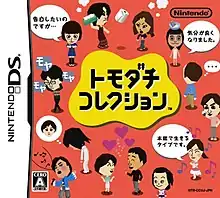| Tomodachi Collection | |
|---|---|
 Cover art | |
| Developer(s) | Nintendo SPD |
| Publisher(s) | Nintendo |
| Director(s) | Ryutaro Takahashi[1] |
| Producer(s) | Yoshio Sakamoto[1] |
| Designer(s) | Masanori Nakagawa[1] |
| Composer(s) | Daisuke Shiiba Asuka Ito[1] |
| Platform(s) | Nintendo DS |
| Release |
|
| Genre(s) | Social simulation |
| Mode(s) | Single-player |
Tomodachi Collection, known in Japan as トモダチコレクション, is a social simulation video game for the Nintendo DS, released in Japan on June 18, 2009. A sequel, Tomodachi Life, was released for the Nintendo 3DS in Japan on April 18, 2013, and in North America and Europe on June 6, 2014.
Gameplay
The cast consists entirely of user created Miis. Players can either transfer Miis directly from their Wii console to their Nintendo DS or create new ones using the in-game Mii Maker. The player chooses their Miis looks and personality, then helps them with their problems, such as making friends and performing other everyday tasks. Additionally, the player can give their Miis clothes, food, and special items to help them gain experience. The Miis can interact with each other and form relationships, such as friendships. When a Mii gains enough experience, they level up and collect rewards. As the game progresses, meeting certain criteria will unlock new areas and shops on the island. One such area is the Question Hall, where the player can ask their Miis questions and have them vote on a certain answer.
Development
Miis had not been featured in early games for the Nintendo DS, originally being developed for the Wii and released on November 19, 2006. Miis first appeared on the DS two years later in 2008, in Personal Trainer: Walking. Tomodachi Collection was released one year later, only in Japan, on June 18, 2009. Although it was only released in Japan, a fan-translation was created and released on November 9, 2013, in American English by jjjewel.[2]
Tomodachi Collection was developed by a small team at Nintendo SPD Group No.1 with Yoshio Sakamoto as a producer. According to a Japanese Iwata Asks interview, it was conceived as a “version that adult women can play” of the 2000 Japan-only fortune-telling Hamtaro video game "Tottoko Hamtaro: Tomodachi Daisakusen Dechu", and was originally titled Otona no Onna no Uranai Techō (大人のオンナの占い手帳, lit."The Adult Woman's Fortune-Telling Notebook"). In the same interview, it was revealed that the fukuwarai-inspired character creation originally developed for Tomodachi Collection became the foundation for Miis.[3]
A western release was considered, according to an interview[4] with Yoshio Sakamoto (incorrectly cited as "Yoshi Sakamoto") by 1Up.com. However, issues with localizing the vocal synthesizer software to handle English words (which was resolved in Tomodachi Life) caused the release to be cancelled.
There is a function only found in the Japanese version of Tomodachi Life that allows players to ‘call’ a Mii from a Tomodachi Collection save file and transfer the Mii onto the 3DS. The newly created Miis are added in the Mii Studio. It is not possible to send a Mii to Tomodachi Collection from the Mii Maker.
Sequel
A sequel for the game on the Nintendo 3DS titled Tomodachi Collection: New Life, was released in Japan on April 18, 2013, and on June 6, 2014 in North America and Europe as Tomodachi Life.[5][6] The game was the best-selling game in Japan during the week of its release, selling about 404,858 units.[7]
Reception
Famitsu gave Tomodachi Collection a rating of 29 out of 40.[8] It was a best-selling game in Japan during the week of its release, selling about 102,000 units.[9] By September 28, 2009, it sold 1.15 million copies in total, making it the fourth-best selling game in Japan in the first half of the 2009 fiscal year.[10] At the end of the 2009–2010 fiscal year on March 31, 2010, Nintendo reported that the game had sold 3.2 million units.[11]
References
- 1 2 3 4 "Official Japanese Iwata Asks with Tomodachi Collection staff". Nintendo. Retrieved 2009-10-08.
- ↑ jjjewel (2020-10-04). "Tomodachi Collection English Translation". GameBrew. Retrieved November 22, 2023.
- ↑ "社長が訊く「トモダチコレクション」" [Iwata Asks: Tomodachi Collection]. Nintendo. June 11, 2009. Retrieved June 3, 2021.
- ↑ "E3 2010: No Plans for Tomodachi Collection in America". web.archive.org. 2016-07-01. Retrieved 2024-01-01.
- ↑ IGN2014, archived from the original on 2014-04-13
- ↑ "What will happen in your Tomodachi Life?".
- ↑ Sahdev, Ishaan (April 24, 2013). "This Week in Sales: Tomodachi Collection Sees Big Launch Sales". Siliconera. Siliconera. Retrieved May 18, 2021.
- ↑ "Revue de presse internationale" [International press coverage] (in French). Gamekult. Retrieved 2009-10-12.
- ↑ John Tanaka (2009-06-26). "Virtual Miis Rule in Japan". IGN. Archived from the original on June 28, 2009. Retrieved 2009-10-12.
- ↑ 2009年度上半期のゲーム市場規模は前年度同期比10.5パーセント減 [Gaming market decreased 10.5 percent in the first half of the 2009 fiscal year] (in Japanese). Famitsu. 2009-10-01. Retrieved 2009-10-12.
- ↑ "Nintendo Fiscal year report". GameSpot. 2010-03-31. p. 1. Retrieved 2010-05-06.
External links
- Official Site (in Japanese)